I have to perform many comparisons between different measurement methods and I have to use the Passing-Bablok regression approach.
I would like to take advantage of ggplot2 and faceting, but I don't know how to add a geom_smooth layer based on the Passing-Bablok regression.
I was thinking about something like: https://stackoverflow.com/a/59173260/2096356
Furthermore, I would also need to show the regression line equation, with confidence interval for intercept and slope parameters, in each plot.
Edit with partial solution
I've found a partial solution combining the code provided in this post and in this answer.
## Regression algorithm
passing_bablok.fit <- function(x, y) {
x_name <- deparse(substitute(x))
lx <- length(x)
l <- lx*(lx - 1)/2
k <- 0
S <- rep(NA, lx)
for (i in 1:(lx - 1)) {
for (j in (i + 1):lx) {
k <- k + 1
S[k] <- (y[i] - y[j])/(x[i] - x[j])
}
}
S.sort <- sort(S)
N <- length(S.sort)
neg <- length(subset(S.sort,S.sort < 0))
K <- floor(neg/2)
if (N %% 2 == 1) {
b <- S.sort[(N+1)/2+K]
} else {
b <- sqrt(S.sort[N / 2 + K]*S.sort[N / 2 + K + 1])
}
a <- median(y - b * x)
res <- as.vector(c(a,b))
names(res) <- c("(Intercept)", x_name)
class(res) <- "Passing_Bablok"
res
}
## Computing confidence intervals
passing_bablok <- function(formula, data, R = 100, weights = NULL){
ret <- boot::boot(
data = model.frame(formula, data),
statistic = function(data, ind) {
data <- data[ind, ]
args <- rlang::parse_exprs(colnames(data))
names(args) <- c("y", "x")
rlang::eval_tidy(rlang::expr(passing_bablok.fit(!!!args)), data, env = rlang::current_env())
},
R=R
)
class(ret) <- c("Passing_Bablok", class(ret))
ret
}
## Plotting confidence bands
predictdf.Passing_Bablok <- function(model, xseq, se, level) {
pred <- as.vector(tcrossprod(model$t0, cbind(1, xseq)))
if(se) {
preds <- tcrossprod(model$t, cbind(1, xseq))
data.frame(
x = xseq,
y = pred,
ymin = apply(preds, 2, function(x) quantile(x, probs = (1-level)/2)),
ymax = apply(preds, 2, function(x) quantile(x, probs = 1-((1-level)/2)))
)
} else {
return(data.frame(x = xseq, y = pred))
}
}
An example of usage:
z <- data.frame(x = rnorm(100, mean = 100, sd = 5),
y = rnorm(100, mean = 110, sd = 8))
ggplot(z, aes(x, y)) +
geom_point() +
geom_smooth(method = passing_bablok) +
geom_abline(slope = 1, intercept = 0)
So far, I haven't been able to show the regression line equation, with confidence interval for intercept and slope parameters (as +- or in parentheses).
